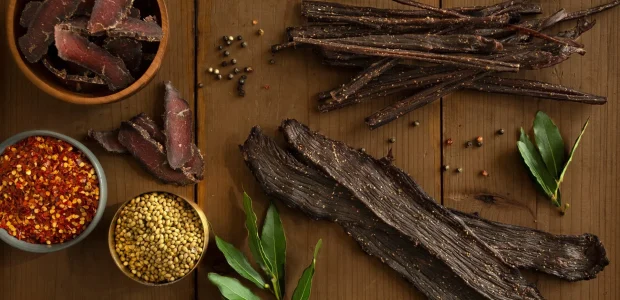Ever bitten into a piece of jerky and thought, “this is good, but I wish there was something more?” Well, meet biltong – South Africa’s legendary air-dried meat that’s rapidly winning over American taste buds. Think of it as jerky’s sophisticated cousin with a passport and a fascinating backstory. Unlike that gas station jerky you’ve tried, biltong offers a depth of flavor and tender texture that might just transform your protein snack game forever.
In this ultimate guide, you’ll discover everything you need to know about this centuries-old delicacy – from its fascinating journey through history to exactly why fitness enthusiasts and foodies alike are falling head over heels for it. Whether you’re a curious food explorer, a protein-seeking gym devotee, or simply someone who appreciates good eating, biltong offers a culinary adventure worth taking. Let’s dive into the savory world of South Africa’s best-kept secret that’s not staying secret much longer.
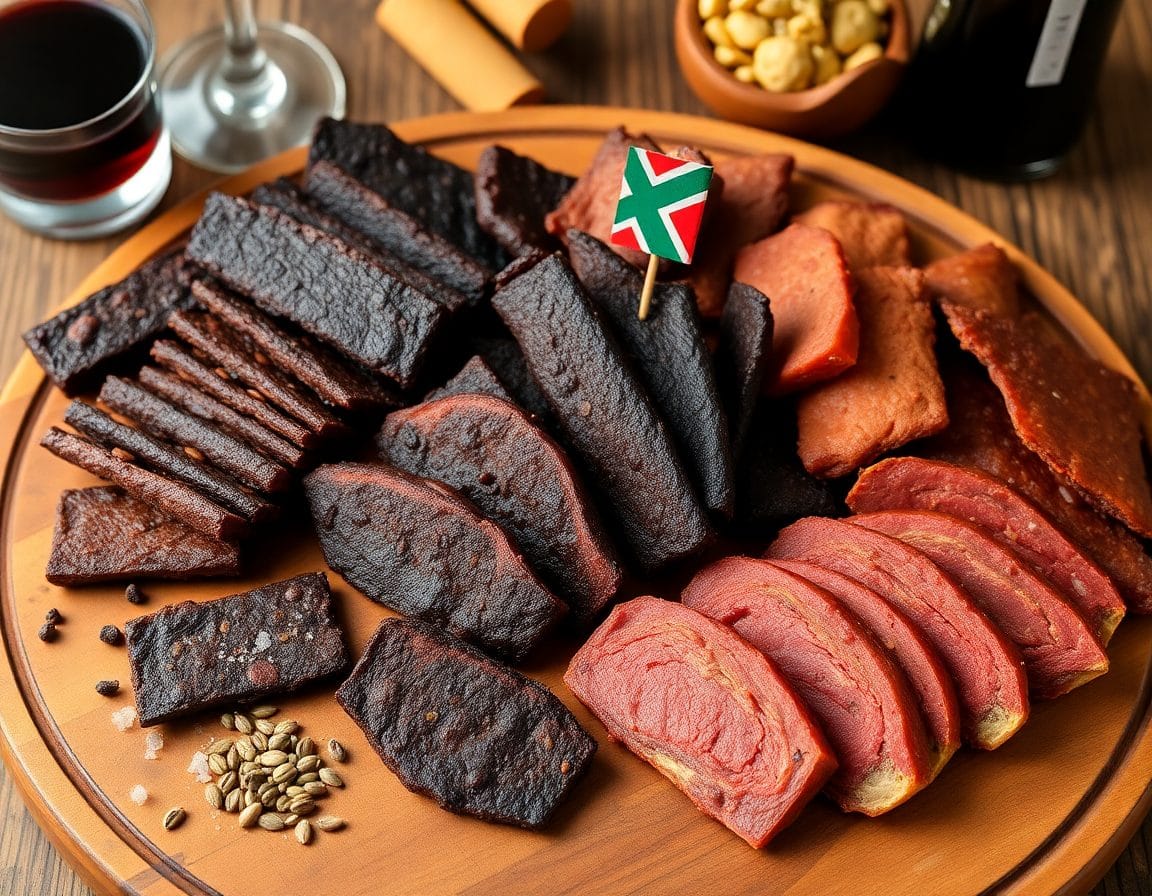
What is Biltong and Its Origins
Biltong is South Africa’s answer to “how do we make meat not just survive, but taste amazing without refrigeration?” It’s air-dried, cured meat that combines savory protein with complex flavors developed through a unique preservation process. The word itself tells you a lot – combining the Dutch words “bil” (buttock) and “tong” (strip), essentially describing strips of meat that have been transformed into portable, long-lasting protein.
What makes biltong’s story so fascinating is its multicultural roots. Before European settlers arrived in southern Africa, indigenous peoples already had their own sophisticated methods for drying and preserving meat in the hot climate. When Dutch colonists (Voortrekkers) arrived in the 17th century, they didn’t simply impose their methods – they observed, learned, and merged their European curing techniques with these local practices. This cross-cultural culinary exchange created something entirely new: the biltong we know today.
This preservation method became crucial during the Great Trek of 1835-1846, when Boer pioneers journeyed across South Africa’s vast landscapes. Without refrigeration, biltong was literally the fuel that powered their exploration. The same fundamental process – vinegar curing followed by air drying – continues to this day, though modern biltong makers might use specially designed drying boxes rather than hanging meat in the open air. What hasn’t changed is biltong’s deeply embedded place in South African culture, where it remains a beloved fixture at sporting events, social gatherings, and everyday snacking.
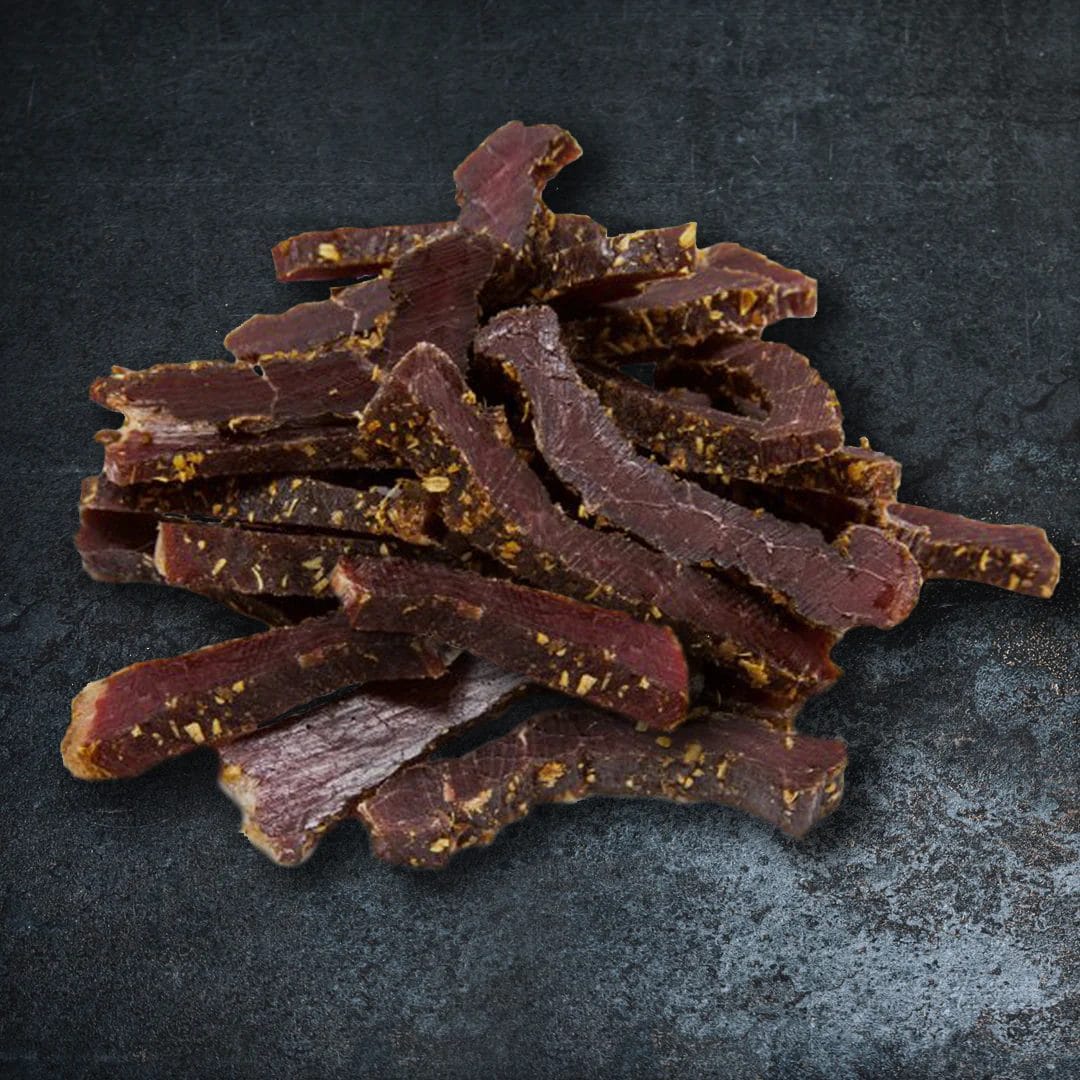
Biltong vs. Beef Jerky: Key Differences
If you’re an American, you probably grew up with beef jerky as your reference point for dried meat snacks. So what makes biltong different enough to deserve your attention? The distinctions aren’t just marketing – they represent fundamentally different approaches to meat preservation.
Preparation Method: Let’s get scientific for a moment, because this matters for both taste and texture. Biltong is cured in vinegar and spices, then air-dried at room temperature for up to a week. This gives it a water activity level of around 0.74-0.77 aw and a slightly acidic pH of 5.5-5.8. In contrast, beef jerky undergoes heat treatment (typically to 160°F/71°C), followed by smoking or dehydration for just a few hours. This faster process produces a water activity of 0.70-0.85 aw and a pH around 5.6-6.0.
What does all that mean for your taste buds? Biltong’s longer, gentler process yields deeper flavor development and a more tender texture that many find addictively satisfying. If you’re curious about how jerky brands like Righteous Felon compare to their biltong counterparts, the differences in preparation method explain most of the variation in taste and texture.
Ingredients and Seasoning: Open your typical jerky package and you’ll often find a laundry list of ingredients. Biltong keeps it refreshingly simple. Traditional biltong uses just five core ingredients: beef, vinegar (usually apple cider or malt), salt, toasted coriander seeds, and black pepper. The vinegar bath isn’t just for flavor – it creates an acidic environment that helps prevent bacterial growth during the drying process.
Jerky, by contrast, commonly includes soy sauce, Worcestershire sauce, liquid smoke, and various sweeteners. The result? Jerky tends to be sweeter and smokier, while biltong delivers a cleaner, more robust meat flavor with aromatic spice notes. It’s the difference between a heavily sauced dish and one that celebrates its primary ingredient.
Texture and Moisture Content: Here’s where biltong truly shines. While jerky typically has a uniform, leathery chew, biltong offers wonderful variety. You can find it “wet” (more moist and tender) or “dry” (firmer, but never tough). This texture range exists because biltong is cut thicker, with the grain, and retains more of its natural moisture. Jerky, sliced thin and against the grain before drying, can’t achieve the same satisfying bite.
The verdict? Both have their place, but if you’re craving something with more depth of flavor and a more satisfying chew, biltong deserves a spot in your snack rotation.
Biltong vs. Beef Jerky: A Complete Comparison
| Feature | Biltong | Beef Jerky |
|---|---|---|
| Origin | South Africa | North America |
| Preparation Method | Air-dried (no heat) | Smoked or heat-dried |
| Drying Time | 3-7 days | 4-6 hours |
| Key Ingredients | Vinegar, salt, coriander, pepper | Soy sauce, sugar, smoke flavor |
| Texture | Varies from moist to dry | Uniformly dry and chewy |
| Cut Style | Thick strips with grain | Thin strips against grain |
| Preservatives | Traditionally none | Often contains additives |
| Moisture Content | Higher (up to 30%) | Lower (10-15%) |
| Flavor Profile | Savory, vinegary, spiced | Sweet, smoky, sometimes spicy |
| Health Profile | High protein, minimal additives | High protein, often with added sugar |
How Biltong is Made
The beauty of biltong lies in its straightforward preparation – a testament to how sometimes the simplest methods yield the most remarkable results. Let’s walk through the process that transforms raw meat into this South African delicacy.
Traditional Ingredients
The magic of authentic biltong begins with surprisingly few ingredients:
- Meat: While beef (particularly cuts like silverside, topside, or sirloin) is most common outside South Africa, traditional South African biltong celebrates game meats. Kudu, springbok, eland, impala, and ostrich aren’t exotic options there – they’re preferred choices that each bring unique flavor profiles. The selection of meat significantly influences the final taste, with game meats offering more complex, earthy notes.
- Vinegar: Either apple cider or malt vinegar forms the foundation of the curing process. The meat soaks for 30 minutes to 2 hours, depending on thickness and recipe. This vinegar bath doesn’t just contribute flavor – it’s a critical food safety step that helps create an inhospitable environment for harmful bacteria.
- Salt: Beyond enhancing flavor, salt plays the crucial preservation role of drawing moisture from the meat, further inhibiting bacterial growth.
- Coriander: Consider this the signature spice of biltong. Whole coriander seeds are toasted to release their essential oils and complex aromas, then coarsely ground. This provides the distinctive flavor that sets biltong apart from other dried meats worldwide.
- Black pepper: Adding both heat and additional antibacterial properties, black pepper completes the core spice profile.
- Regional variations: Depending on family traditions and regional preferences, you might find additions like brown sugar for subtle sweetness, baking soda to tenderize tougher cuts, paprika for color, or chili for heat. Each family’s recipe tells a story of tradition and taste preference.
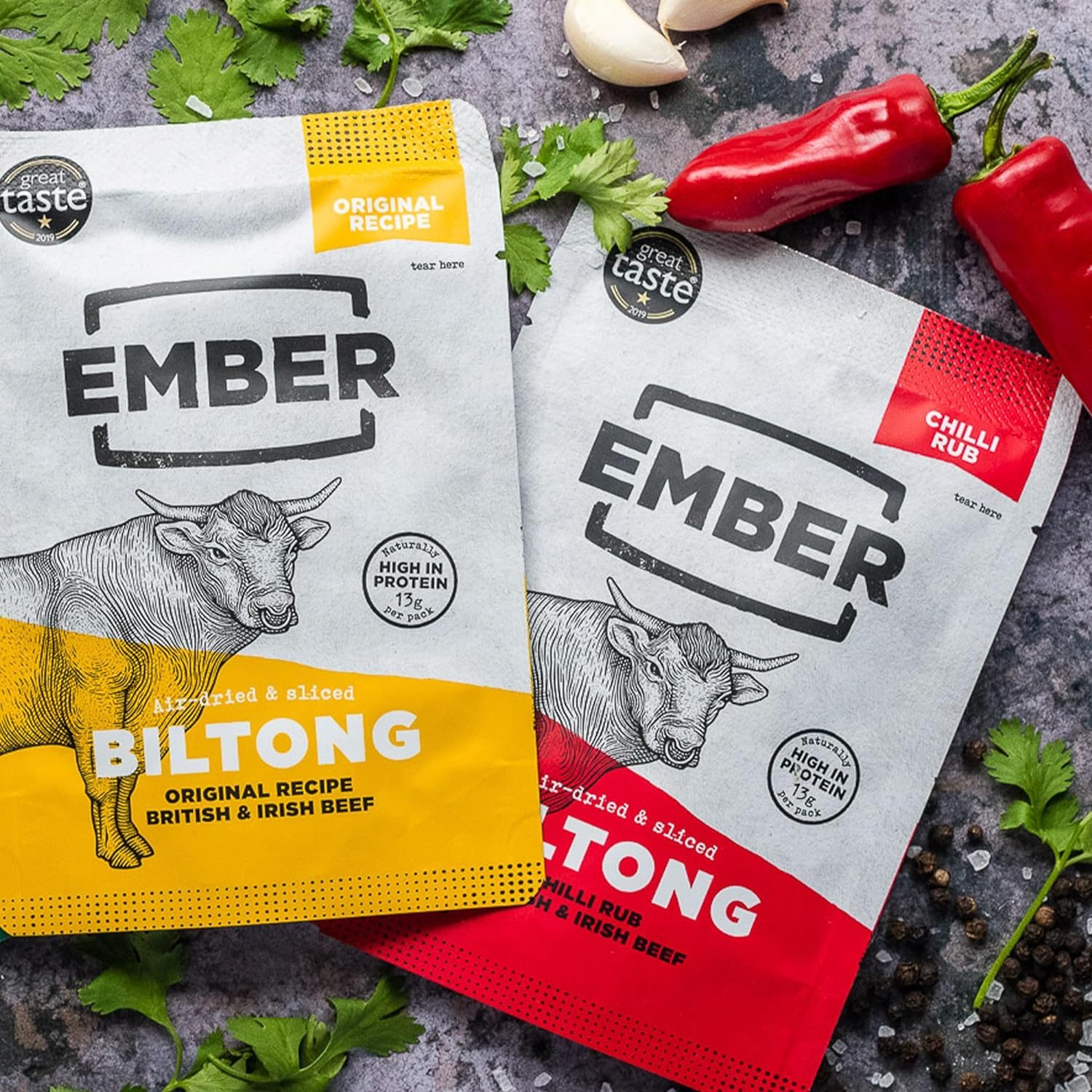
Basic Preparation Process
The transformation from fresh meat to biltong follows these six steps:
- Cutting the meat: Unlike jerky’s thin slices, biltong starts with substantial strips approximately 1-inch thick, cut with the grain for that characteristic texture. Think of hearty slabs rather than slim slices.
- Vinegar bath: The meat takes a vinegar soak, which begins the preservation process and contributes to flavor development. This step distinguishes biltong from many other dried meats worldwide.
- Spice coating: After the vinegar bath, the meat gets a generous coating of the spice mixture, with special attention to edges and crevices. This isn’t a light sprinkle – proper biltong has a visible spice crust.
- Initial curing: The seasoned meat rests in a cool place for 6-24 hours, allowing the salt to draw moisture from the meat and the flavors to begin penetrating beyond the surface.
- Hanging to dry: The prepared meat strips are then suspended in a well-ventilated area to dry slowly. Traditionally this happened outdoors in South Africa’s dry climate, but modern biltong producers use specialized drying boxes or cabinets that control airflow, temperature, and humidity – bringing predictability to a process once dependent on weather.
- The waiting game: Perhaps the hardest part – patience. The drying process typically takes 3-7 days depending on thickness, desired texture, and environmental conditions. Unlike jerky, biltong is never exposed to high heat, allowing for complex flavor development similar to aged cheese or fine wine.
This slow air-drying process is the secret behind biltong’s distinctive texture and concentrated flavor. The spices gradually permeate the meat as it slowly loses moisture, resulting in a product that captures both the essence of the meat and its seasoning in perfect balance.

Health Benefits of Biltong
In a world of processed snacks with ingredient lists longer than some novels, biltong stands out as refreshingly simple. But beyond its clean ingredients, biltong packs some serious nutritional credentials that have helped fuel its growing popularity among health-conscious Americans.
Nutritional Profile
If you’re counting macros or just trying to eat more mindfully, biltong deserves your attention. Here’s what the science tells us about this protein powerhouse:
- Protein content that means business: With approximately 50-55g of protein per 100g (50-55% by weight), biltong outperforms most other protein sources in concentration. For comparison, chicken breast contains about 31g of protein per 100g. This makes biltong particularly valuable for athletes, active individuals, and anyone looking to increase their protein intake efficiently.
- Carb counters, rejoice: Whether you’re following keto, paleo, or just watching your carb intake, biltong fits perfectly into your plan with just 0.1-2.8g of carbohydrates per 100g. That’s practically negligible and makes it one of the cleanest protein sources available.
- Variable fat content to suit your needs: Depending on the cut used, biltong contains between 1.3-10.4g fat per 100g. Leaner cuts provide a lower-fat option, while slightly fattier varieties offer more flavor and satiety. Either way, you’re looking at approximately 200-300 calories per 100g – making it calorie-efficient compared to many snacks.
- Micronutrient bonanza: Biltong delivers iron (3.5-5mg per 100g) and zinc (7-10mg per 100g) – two minerals many Americans don’t get enough of. It’s also packed with B vitamins, particularly vitamin B12 (2.0-4.0 μg per 100g), which is essential for energy metabolism and brain function.
- The sodium situation: Let’s be honest – like most preserved foods, biltong contains sodium (1,000-2,500mg per 100g depending on preparation). If you’re watching your sodium intake, enjoy biltong in moderation. That said, its salt content serves a preservation purpose rather than simply boosting flavor.
Key Health Advantages
This impressive nutritional profile translates to several practical benefits:
- Muscle recovery and building: The complete protein profile with all essential amino acids makes biltong excellent for post-workout recovery. Its concentrated nature means you don’t need to eat much to get substantial protein.
- Sustained energy without crashes: The combination of protein and minimal carbohydrates provides steady, sustained energy without the blood sugar rollercoaster common with carb-heavy snacks.
- Convenience without compromise: In our busy lives, nutritional quality often takes a backseat to convenience. Biltong offers both. As a shelf-stable, ready-to-eat food, it provides quality nutrition without preparation – perfect for busy professionals, travelers, hikers, or parents on the go.
- Iron boost for active people: The highly bioavailable iron in biltong helps prevent the fatigue associated with low iron levels – particularly beneficial for athletes, women of reproductive age, and anyone with increased iron needs.
- Clean eating made simple: Traditional biltong aligns well with clean eating approaches, using natural preservation methods (salt, vinegar, air-drying) rather than the chemical preservatives common in many processed meats.
For the nutrition-conscious who don’t want to sacrifice flavor, biltong represents that rare find – a food that’s both delicious and nutritionally valuable. Just remember that moderation is key, especially if you’re watching your sodium intake.
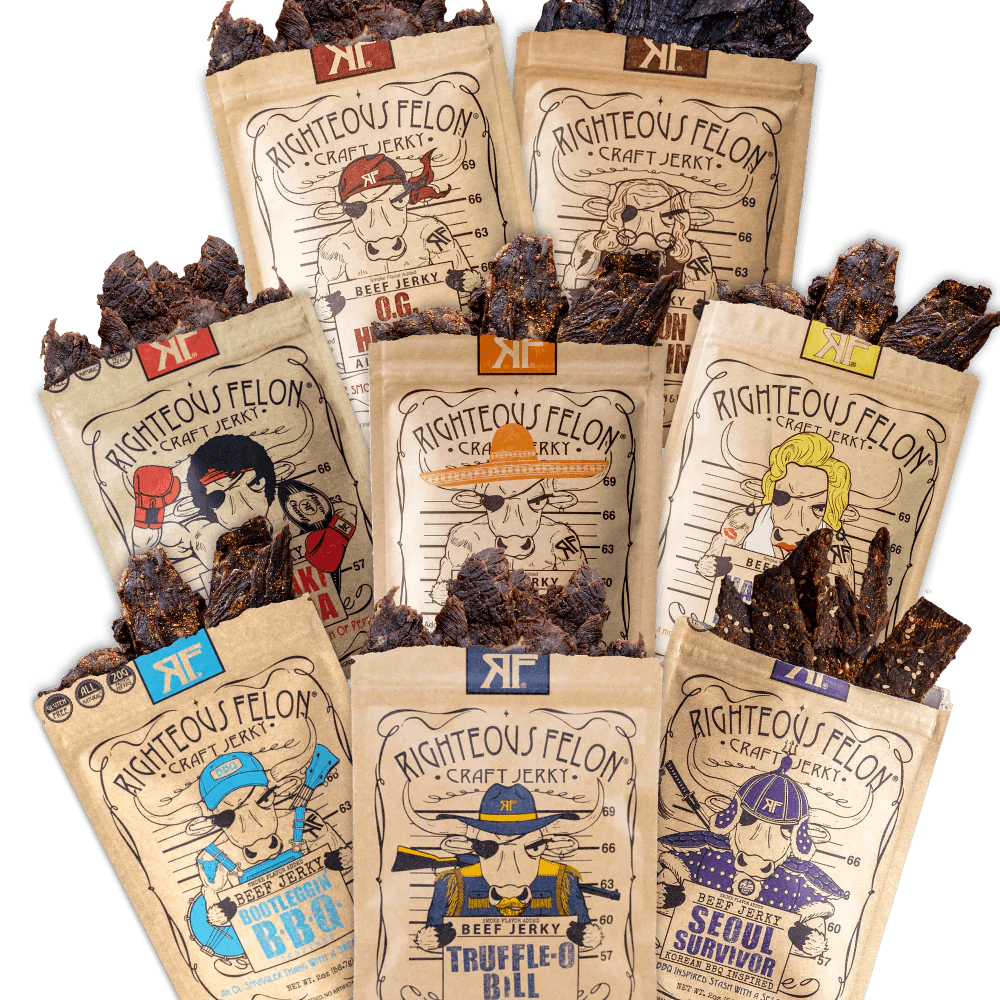
How to Enjoy Biltong
Now that you understand what biltong is and why it’s worth trying, let’s talk about how to actually incorporate it into your life. Biltong’s versatility might surprise you – it’s far more than just a snack eaten straight from the package.
Creative Ways to Eat Biltong
While there’s absolutely nothing wrong with enjoying biltong on its own (it’s delicious!), here are some inspired ways to use it:
- Protein-rich snacking: The most straightforward approach – grab a piece when hunger strikes between meals or after a workout. It travels well, doesn’t need refrigeration for day trips, and won’t leave your fingers greasy like many other snacks.
- Elevate your salads: Tired of chicken on your salad? Thin slices of biltong add protein and a flavor punch that transforms ordinary greens into something special. Try it with avocado, cherry tomatoes, and a light vinaigrette – the flavors complement each other perfectly.
- Upgrade your breakfast: Crumble biltong into your morning scrambled eggs or omelet for a South African twist on breakfast. The savory, spiced notes wake up your taste buds and provide a protein boost to start your day.
- Charcuterie board star: Position biltong alongside cheeses (particularly sharp cheddar or gouda), olives, and fruit for a conversation-starting addition to your next charcuterie board. It pairs surprisingly well with a glass of bold red wine.
- Gourmet grilled cheese: Layer thin slices of biltong with your favorite melting cheese between bread for a grown-up grilled cheese that’s anything but ordinary.
- Flavor booster: Finely chopped biltong makes an excellent topping for baked potatoes, sprinkled over soups, or even as a pizza topping that adds both flavor and protein.
- Cooking ingredient: In South Africa, ground biltong (known as “biltong powder”) is used as a seasoning in stews and soups or sprinkled over popcorn for a savory snack.
Where to Find Biltong in the US
The good news is that biltong is becoming increasingly accessible in the United States. Here’s where to look:
Purchasing Options:
- Specialty stores: Cities with South African expatriate communities often have shops selling authentic biltong. These small businesses typically make biltong using traditional methods and recipes.
- Online retailers: Numerous online shops now ship biltong nationwide. We’ve reviewed some of the top biltong brands available in the US to help you find quality options that deliver authentic flavor. Brands like Brooklyn Biltong, Ayoba, and Stryve have made quality biltong accessible to Americans everywhere.
- Health food stores: As biltong gains popularity in fitness communities, health-focused retailers like Whole Foods and specialty health food stores have begun carrying select brands.
- Specialty meat markets: Craft butchers and charcuterie shops in major cities sometimes make their own biltong or carry brands they’ve vetted for quality. Some American companies like Righteous Felon have created their own distinctive takes on biltong that balance South African tradition with American flavor preferences.
When shopping for biltong in the US, look for products made with minimal ingredients. The best options will list only meat, vinegar, salt, and spices without artificial preservatives or excessive additives.
Making Biltong at Home:
For the culinary adventurers, making biltong at home is surprisingly doable and allows complete control over ingredients and flavor. Here’s what you’ll need:
- Basic equipment:
- A biltong box (you can purchase one or DIY with a wooden box, light bulb for gentle heat, and small fan)
- Hooks for hanging meat (stainless steel is best)
- A sharp knife for cutting meat
- Simple steps:
- Select quality meat (beef silverside or topside works well)
- Cut with the grain into 1-inch thick strips
- Soak in vinegar for 30 minutes to 2 hours
- Coat thoroughly with your spice mixture
- Hang in your biltong box with good air circulation for 3-7 days
The homemade approach lets you customize the thickness, dryness, and spice level exactly to your preference. Plus, there’s something deeply satisfying about creating this ancient food in your modern kitchen.

Frequently Asked Questions About Biltong
As biltong continues its journey into American food culture, certain questions come up regularly. Let’s address the most common ones with straight facts.
Is biltong healthier than beef jerky?
In most cases, yes. Traditional biltong typically contains fewer additives, no added sugar, and lower sodium levels compared to many commercial jerky products. The key difference lies in the ingredients list – biltong’s is remarkably short and recognizable. Additionally, the air-drying process used for biltong (versus the heat-drying of jerky) may better preserve certain nutrients.
That said, not all products are created equal. Some commercial biltong brands available in the US have adapted their recipes for American palates, potentially adding ingredients not found in traditional versions. Always check the label if particular ingredients concern you.
What meat is used for biltong?
While beef is most common in the US market (particularly cuts like silverside, topside, and sirloin), traditional South African biltong showcases a much wider range of meats. Game meats like kudu, springbok, impala, and ostrich aren’t just specialty options – they’re preferred choices that each bring unique flavor profiles. The key is selecting meat with good muscle structure and minimal sinew.
Modern variations have expanded even further, with chicken, fish, and even mushroom “biltong” for vegetarians. Each offers a different flavor experience while maintaining the core preparation method.
Why is biltong not widely available in the US?
Regulatory hurdles have been the biggest obstacle. The USDA Food Safety and Inspection Service (FSIS) regulates dried meat products and generally requires a “lethality treatment” (heat processing) to kill pathogens – typically heating meat to 160°F (71°C). Biltong’s traditional ambient-temperature air-drying process doesn’t meet this requirement.
Fortunately, the landscape is changing. Some manufacturers have received approval for biltong production in the US by demonstrating safety through Hazard Analysis Critical Control Point (HACCP) plans and implementing proper safety controls. There’s growing regulatory acceptance of traditional methods that incorporate modern food safety principles.
Beyond regulations, biltong faces two additional challenges in the US market:
- Limited cultural familiarity compared to jerky
- A longer, more labor-intensive production process that increases costs
Despite these challenges, biltong is gaining solid footing in the American market through specialty shops, South African stores, and numerous online retailers.
How long does biltong last?
Your biltong’s shelf life depends on how it’s prepared and stored:
- In a cool, dry place (50-77°F/10-25°C with humidity below 55%) in an airtight container, non-vacuum packaged biltong typically lasts 2-3 months.
- Vacuum-sealed biltong goes the distance – up to 6-12 months when properly dried and stored.
- Refrigeration (34-39°F/1-4°C) extends shelf life by slowing oxidative rancidity, though it may slightly alter the texture.
The science behind this stability relates to water activity – biltong’s low water activity (below 0.85) inhibits most bacterial growth. Once opened, biltong is best consumed within 1-2 weeks for optimal quality.
You’ll know it’s time to say goodbye to your biltong if you notice off odors, discoloration, or visible mold. Typically, quality decline (texture hardening and flavor changes) occurs before safety issues arise.
What does biltong taste like?
Imagine concentrated beef flavor with aromatic spices, a hint of vinegar, and none of the sweetness or smokiness of jerky. Biltong delivers a clean, robust meat flavor enhanced by coriander and black pepper, creating a savory, slightly tangy experience.
The texture varies dramatically from slightly moist and tender to firm and dense depending on drying time. This textural range is part of biltong’s appeal – you can find the style that best suits your preference.
First-time tasters often describe biltong as tasting more “authentic” or “natural” than other dried meat products. The flavor is straightforward yet complex – celebrating the meat itself rather than hiding it behind heavy seasoning or sweetness.
Conclusion: Why Biltong Deserves a Place in Your Culinary Repertoire
Biltong isn’t just another food trend – it’s a centuries-old tradition that happens to align perfectly with modern nutritional values and busy lifestyles. From its fascinating cross-cultural origins to its impressive nutritional profile, biltong represents food preservation wisdom that has stood the test of time.
In South Africa, biltong remains more than just food – it’s a cultural cornerstone. You’ll find it at rugby and cricket matches, at weekend braais (barbecues), and as the centerpiece of social gatherings. For South African emigrants worldwide, biltong maintains a vital connection to home and heritage.
What makes biltong truly special is how it balances simplicity and complexity – basic ingredients and ancient methods yielding nuanced, satisfying flavors. As Americans increasingly seek out clean-label, nutrient-dense foods with global heritage, biltong is perfectly positioned to move from specialty status to mainstream acceptance.
Whether you’re drawn to its cultural story, impressive protein content, or simply curious about its unique taste, biltong offers an accessible entry point to South African culinary traditions. Try it as a post-workout snack, incorporate it into your cooking, or share it with friends as a conversation piece – biltong’s versatility ensures there’s a way for everyone to enjoy this protein-rich food.
Ready to experience this South African tradition yourself? Look for quality biltong at specialty stores, explore our guide to the best biltong brands available online, or embrace the adventure of making your own at home. Your taste buds – and your body – will thank you for discovering this nutritious, delicious protein treasure that’s been centuries in the making.

